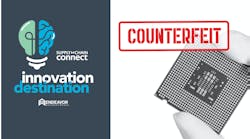Few companies set rules for buying from independent distributors, survey finds
In a new survey from Penton Media’s Design Engineering and Sourcing group, buyers from a range of end markets say they regularly purchase electronic components from the open market, but comparatively few say their companies have official policies in place to guide such buying decisions.
More than 2,300 subscribers to Electronic Design, Machine Design and SourceESB participated in Penton’s first annual Counterfeit Electronic Components Survey, which asked about top concerns and sought to gauge industry attitudes and awareness of the counterfeit components problem. Subscribers include design engineers and procurement professionals.
Half of survey respondents said they purchase electronic components from the open market, but just 23% of respondents said their companies have a policy in place for buying from independent sources.
Industry watchers are hopeful the latter point will change as government agencies step up requirements for sourcing electronic components. Government purchasing organizations and contractors are taking new steps to keep counterfeits out of the defense supply chain, most notably asking their suppliers to prove that they have a counterfeit mitigation plan in place. The requirement arose from the National Defense Authorization Act, signed into law by President Obama late last year, which includes new rules for purchasing electronic components.
Such requests are affecting independent and authorized distributors alike. In an interview with SourceESB/Globalpurchasing.com this fall, distribution executive Kevin Sink said more customers are seeking counterfeit mitigation plan documentation as a result of new requirements from the NDAA’s Section 818, which addresses the need for enhanced inspection and reporting procedures among government agencies and contractors. Sink is vice president of total quality for authorized distributor TTI, Inc., and is a member of SAE International’s G19 Committee, which works to address prevention, detection, and electronics industry response to the counterfeit threat.
“I think it has reached critical mass now,” Sink said of the counterfeit problem earlier this fall. “Section 818 of the NDAA and the report from the Senate Armed Services Committee in May—those two things together have kind of forced [companies into action]. Customers are requiring suppliers to make a statement that they have a counterfeit mitigation program in place. I probably get three of these [requests] a week, when three years ago I didn’t get any.”
Industry observers also say such actions are putting increased pressure on independent distributors to develop stricter controls and more advanced testing procedures for detecting counterfeit parts.
“Talk at [industry] meetings over the last few years has increasingly been focused on the [problems with] non-conforming product in the marketplace and the need for independents to increase their vigilance, their inspection ability, their insurance, and their resources that are solely focused on making sure that they’re selling good products,” Matt Hartzell, chief operating officer for independent distributor NF Smith & Associates, said earlier this fall. “[As a result], it’s getting tougher for the smaller companies in this industry to do business. And I think you’ll see that continue.”










